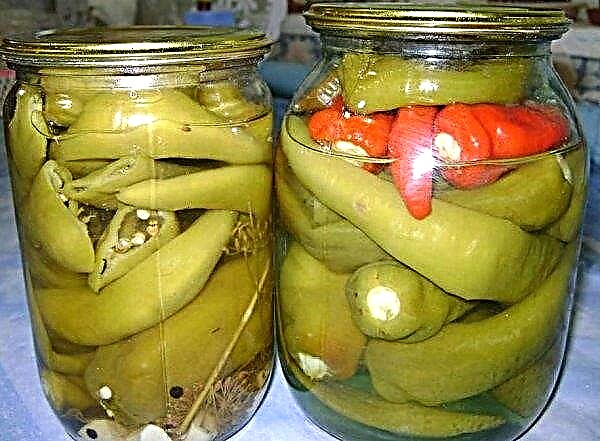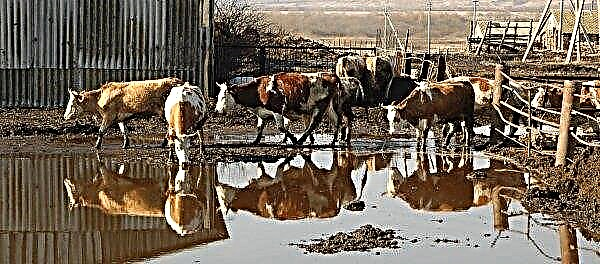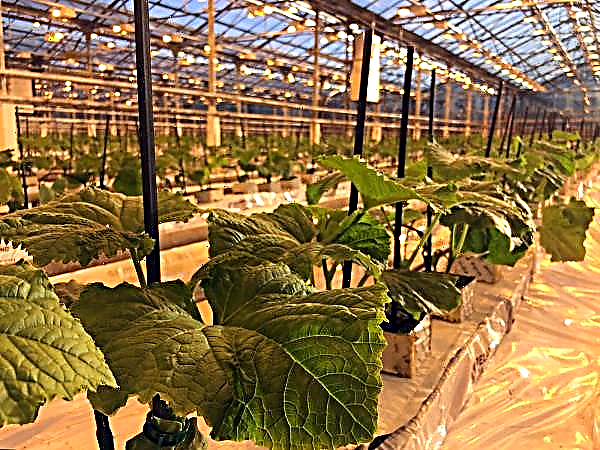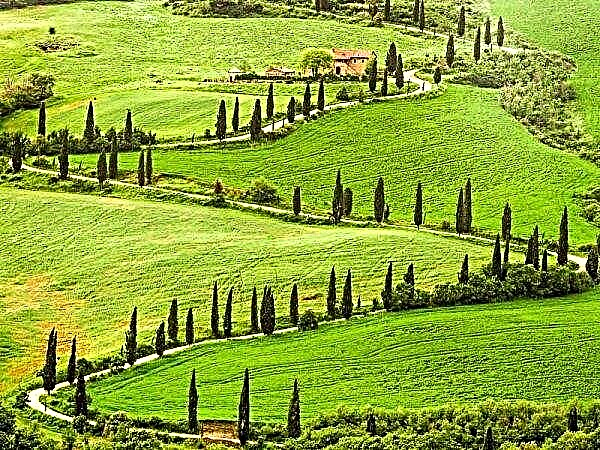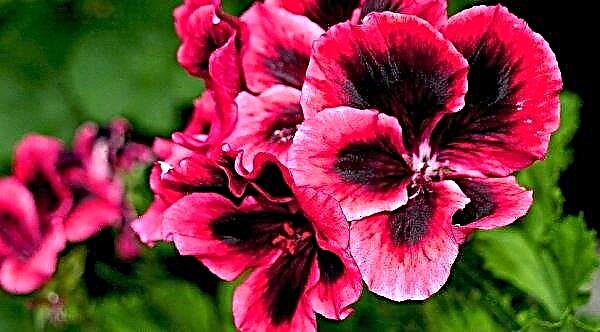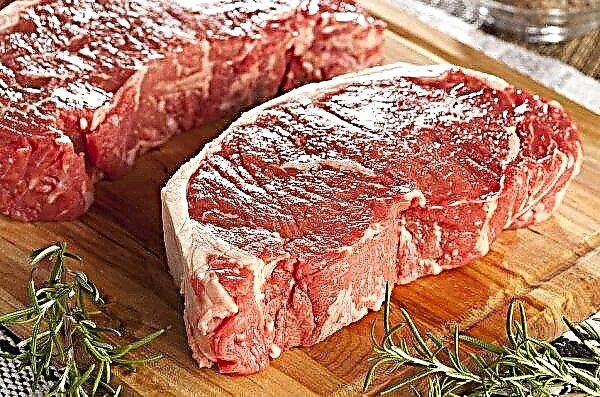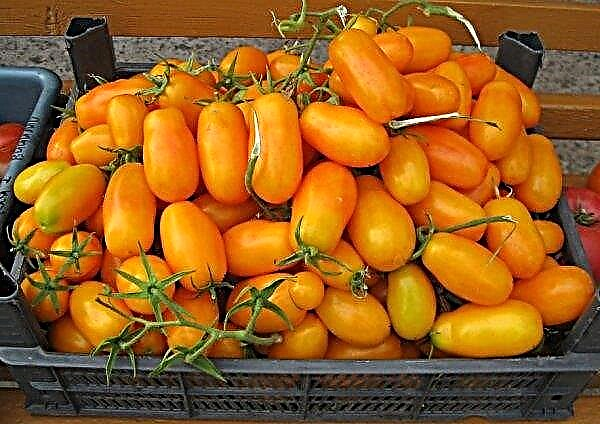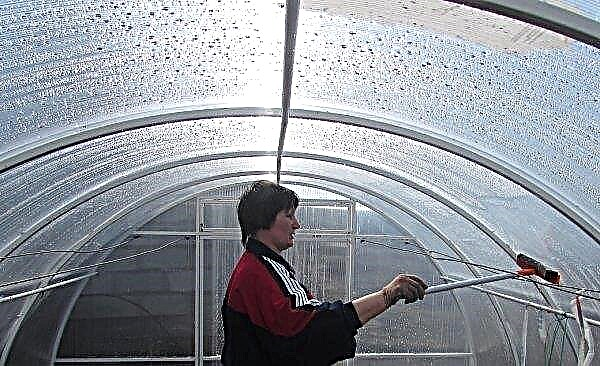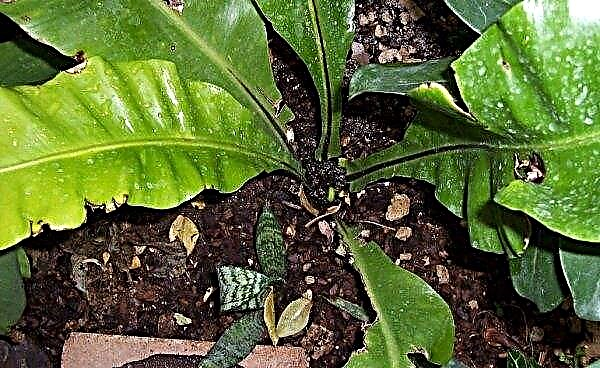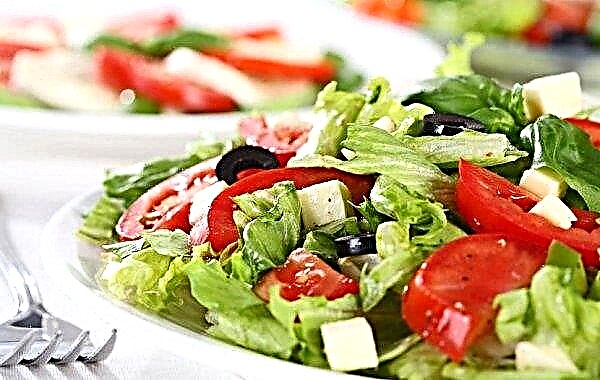Common caraway seeds grow on the territory of Eurasia, mainly in the temperate zone. It is often used in the kitchens of European countries as a spice, it can be grown on a personal plot. In the article you will familiarize yourself with ordinary caraway seeds, its benefits and uses in various fields of activity, to which group of spices it belongs, what are the contraindications for use, how to grow and store the culture.
Plant characteristics
We suggest that you familiarize yourself with ordinary caraway seeds and learn about the places of its growth, as well as what types of caraway seeds are.
What does it look like?
Common cumin in science is written in Latin Carum carvi and belongs to the umbrella family. Among other items - field anise (wild), cumin, cumin, goats, gunba, ganus.
In this two-year-old plant, single erect stems branch well in the upper part and grow up to 30–80 cm tall. Outside are smooth, and inside are hollow. The root system is pivotal with a fleshy root. The leaves are elongated, 2-3 times pinnately dissected, similar to the tops of carrots. Their length can be 6–20 cm, and their width can be up to 10 cm. The leaves coming from the roots have long petioles, and the leaves growing at the top of the plant are short.
The leaves are elongated, 2-3 times pinnately dissected, similar to the tops of carrots. Their length can be 6–20 cm, and their width can be up to 10 cm. The leaves coming from the roots have long petioles, and the leaves growing at the top of the plant are short.
It blooms in the first half of summer with an umbrella with small white or pinkish flowers. The inflorescence is 4–8 cm in size and has from 8 to 16 rays.
After flowering, a fetus is formed - an elongated flattened oviparcus 3 × 2.5 mm in size. It has a brown color and is divided into 2 sickle-shaped half-fruits. They have a strong spicy smell and a slightly burning taste.
Did you know? Common caraway seeds were found during archaeological excavations in the territory of Mesopotamia, which indicates their use as a spice in the 3rd millennium BC. e.
Where is it growing?
In the wild, it is found in the forests and forest-steppes of Europe, in the Asian region with a temperate climate and some subtropical regions of India and Pakistan. It can be found not only on the edges of the forest and meadows, sometimes found right at the shelter. But its cultivation occupies much more territories. It is grown not only in many countries of Europe and Asia, but also in the North of Africa, in New Zealand and America.
But its cultivation occupies much more territories. It is grown not only in many countries of Europe and Asia, but also in the North of Africa, in New Zealand and America.
Types of Caraway Seeds
This genus of plants has 30 species, but people use only ordinary caraway seeds. However, in culinary seasoning, there are several more spicy herbs that have the word “caraway” in their name but are not related to its genus.
Let's get to know them briefly:
- Roman caraway (Cumīnum cymīnum). It has many names - zira, azhgon, Volosh caraway seeds, Indian caraway seeds, cumin, cumin, kammun, zara. A plant from the genus Umbrella family. Seeds are outwardly similar to ordinary caraway fruits, but have a different taste (with nutty notes) and a strong pungent aroma. There are two varieties of caraway seeds - black (kirmansky) zira and white (persian). The latter is more famous and is a popular spice for pilaf. It is added to dishes from meat, fish, legumes and potatoes, in pastries and marinades.
- Black cumin (Nigēlla satīva). It has other names - sowing nigella, Roman coriander, nigella, kalingi, sedan, seydan. An annual herb from the buttercup family, which is now grown everywhere. The plant uses small black trihedral seeds with a finely tuberous surface.
They have a sharp bitter taste and delicate aroma. Black cumin is popular in Turkish cuisine and often appears in dishes of other Arab countries. There they put it in almost all dishes.


All these fragrant seeds are used not only in cooking, but also as a medicine. Black caraway seeds (chernushka) and ordinary are used for the manufacture of cosmetics. Arabs consider chernushka oil a cure for all diseases.
Did you know? The medieval healer Avicenna in his writings mentions many medical recipes based on nigella.
Chemical and vitamin composition
The composition and nutritional value of 100 g of caraway seeds is as follows:
- proteins - 19.8 g;
- fats - 14.6;
- carbohydrates - 11.9 g;
- water - 9.87 g;
- ash - 5.9 g.
| Vitamins: | Minerals: |
|
|
In addition, the seeds contain up to 7% of essential oils, flavonoids (including quercetin, kempferol and coumarins). Among fats, polyunsaturated fatty acids (linoleic, linolenic, omega-3 and omega-6) are contained.
Properties of cumin for the human body
Common cumin, due to its rich composition, will benefit people who use it. However, when taking in large quantities, it should be borne in mind that this spice has contraindications.
Useful properties of caraway seeds
- Common cumin has the following positive effects on the human body:
- improves digestion and increases appetite;
- helps with excessive accumulation of gases;
- used as a diuretic;
- relieves constipation;
- activates the work of the endocrine glands;
- removes sputum and is useful for coughing;
- has a choleretic effect and is useful for the liver;
- exhibits antiseptic properties;
- inhibits pathogenic microflora, processes of decay and fermentation, parasites;
- strengthens the immune system;
- possesses antioxidant activity;
- well affects metabolic processes;
- acts on the body soothingly, relieves cramps, helps with insomnia and migraines;
- tones the body, stimulates physical and mental activity.
 These seeds are useful for adults and children, especially lactating women, as they can cause a rush of milk and help to remove excess gas, eliminate constipation, and are useful for colic in a baby. Also useful for women planning a pregnancy.
These seeds are useful for adults and children, especially lactating women, as they can cause a rush of milk and help to remove excess gas, eliminate constipation, and are useful for colic in a baby. Also useful for women planning a pregnancy.They can be used by pregnant women, but in limited quantities, they can help with bloating and constipation. They can be used for painful menstruation.
In men, this plant will not only increase potency, but also improve sperm quality, and will serve as an auxiliary treatment for problems with the prostate.
Did you know? In the Middle Ages, caraway seeds not only seasoned dishes, but also cooked a love potion from it, put them in amulets.
There are many recipes for losing weight with this plant, since its fruits and tea from them improve metabolism.
Harm and possible contraindications
During pregnancy, you can not consume a lot of caraway seeds, since their tonic properties affect the uterus and can cause miscarriage or premature birth.
- The following contraindications for taking caraway seeds are:
- allergic to this product;
- exacerbations of pancreatitis and gastrointestinal tract diseases;
- increased acidity;
- after a heart attack and with thrombophlebitis;
- cholelithiasis.

Features of the use of caraway seeds
Seeds, herbs and essential little caraway seeds are used for different purposes.
In cosmetology
Cumin has found application in cosmetology, thanks to its useful elements. Oil from it is popular in this area.
It has the following properties:
- smoothes wrinkles, makes it elastic, promotes collagen production;
- It helps against stretch marks on the skin;
- tones the skin;
- helps against inflammation and rashes, peeling, acne;
- makes the skin soft and smooth;
- protects against ultraviolet rays, prevents skin aging;
- helps with swelling and cellulitis;
- strengthens hair roots, helps against dandruff.
 Due to these properties, caraway seed oil is used in the manufacture of face and hair masks, cellulite products, creams, shampoos, balms and lotions.
Due to these properties, caraway seed oil is used in the manufacture of face and hair masks, cellulite products, creams, shampoos, balms and lotions.With oily skin and the presence of blackheads, it is recommended to wash with a decoction of spices. For this purpose, 1 tsp. caraway seeds are poured with 250 ml of boiling water and allowed to infuse for 30-40 minutes. They wash the face with this broth and do not wipe it with a towel, but let the broth dry on the skin of the face.
In the presence of dandruff, it is recommended to rub such a decoction into the scalp, as well as rinse the hair after washing with shampoo.
Did you know? The smell of esters Carum carvi helps to cope with mental tasks, restores energy, stimulates the nervous system. Caraway aroma is combined with the smell of oranges, basil, ginger, chamomile, lavender, laurel, geranium.
In folk medicine
The most common use of cumin seeds after cooking is for treatment. Traditional medicine offers the following recipes using this spicy herb:
Traditional medicine offers the following recipes using this spicy herb:
- For immunity. Take every day 1 teaspoon of ground caraway seeds with water. Children 6-12 years old are shown a dose half as small - 1/2 tsp.
- From mastitis. Knead a cake of rye flour, chopped caraway seeds, fresh peppermint and hot water. Apply a warm cake to the chest area. The procedure is carried out for several days.
- To remove toxins from the body and lose weight. Tea is prepared from the seeds of this seasoning, for which 1 hour seasoning is poured with boiled water with a volume of 300 ml and kept on low heat for 10 minutes. Then let it brew for 60 minutes and drink a third of a glass 3 times a day for 15-20 minutes. before eating. Tea can be prepared in another way: 1 hour of ground seeds pour 250 ml of boiling water, stand for 10 minutes. Drink the infusion before breakfast. You can add a little honey for the taste. Such tea helps with high blood pressure, gynecological problems, kidney disease and asthma, as it has a diuretic effect and removes bile from the body. It also helps with insomnia.
- To strengthen the nervous system. The seeds ground in the coffee grinder are mixed 1: 1 with honey. For a decade, they use 1 hour per day. Chew thoroughly.
- Constipation. Pour 1 cup boiling water 2 tbsp. seeds and boil for 15 minutes in the steam bath. Then the broth is insisted for 45 minutes. and filter through a sieve. Drink 125 ml after meals 2 times a day.
- For nausea. To do this, just chew some seeds of this spice.
- For appetite. Drink a pinch of crushed caraway seeds with water 30 minutes before eating.
- Flatulence. Insist in a thermos glass of boiling water with 1 tbsp. seed. Accepted in 30 minutes. before each main meal 2 tbsp. l
- Cough. Pour a glass of boiling water 1 tbsp. seeds, insist, cool. Filter and drink up to 6 times a day for 2-3 tbsp. infusion. You can add sugar or honey to it.
- BPH. It is useful to consume tea during the day. For its preparation, 1 tbsp. fruits pour 1.5 cup boiling water and cook for 5-7 minutes. Then the broth is wrapped for 10 minutes. and filter.
- To enhance lactation. In 0.5 l of water boil 2 hours of fruit for 5 minutes. Drink 125 ml 3 times a day before meals.
Important! If you have health problems, you should consult a doctor. Cumin for serious ailments is used as an adjunct treatment and will not replace the main therapy.
In cooking
Cumin is best known in pastries, but it can be used for different dishes. Not only seeds are used, but also the stem, root, that is, all parts of this spicy plant. For example, dessert dishes are prepared from the root.
Caraway fruits are an excellent spice for bakery products, kvass and beer. They can be put in pilaf, sausages and canned food. They add spicy taste and aroma to all dishes. Moreover, seasoning is combined with dairy products (yogurt, kefir, cottage cheese, cheese). To enhance the smell of spices, it is heated in a pan.
They add spicy taste and aroma to all dishes. Moreover, seasoning is combined with dairy products (yogurt, kefir, cottage cheese, cheese). To enhance the smell of spices, it is heated in a pan.
Strong alcohol is insisted on caraway seeds, while Scandinavians have caraway vodka. It is brewed like tea and put into tea collections. Cumin is used for salting and pickling vegetables. In this preservation, you can put not only seeds, but also twigs, plant umbrellas.
Fresh caraway branches contain a lot of carotene and vitamin C, therefore it is recommended to include greens in spring salads in May.
Whole seasoning fruits are thrown when cooking for 10-15 minutes. before the end of the process, so that the seasoning reveals the aroma and gives the dish a taste. Ground seeds are added to the dish at the end of its preparation.
Growing rules
Caraway seeds are resistant to cold, so the seed of this spice is planted in early spring or autumn before frost. Seeds germinate at + 6 ... + 7 ° С. For planting, it is better to choose well-permeable nutrient soils with a neutral reaction. About 2 g of seeds are consumed per 1 m².
Seeds are sown in rows with an interval between them of about 35–45 cm. The sowing depth is 1.5–2.5 cm.
To sprouts sprouted earlier, the planted area is covered with a film. Seeds hatch in 2-3 weeks. Plants tolerate brief temperature drops. After the shoots have grown, thinning is carried out, leaving a gap between them of 15–20 cm. The landing site is chosen in a well-lit place, the plant does not like shading. Good predecessors are peas, beans, and beans.
The landing site is chosen in a well-lit place, the plant does not like shading. Good predecessors are peas, beans, and beans.
Important! When growing spices, do not mulch the soil - this adversely affects the plant.
Further plant care is as follows:
- After 40 days, caraway seeds bloom, and this process lasts 1.5 months. During this period, it is necessary to introduce phosphate-potash fertilizers into the soil. Top dressing is carried out sparingly, as excess fertilizer can adversely affect the plant.
- It is important to water the planting during germination and stalking. In another period, watering is optional.
- It is necessary to periodically loosen the soil with the removal of weeds that pull nutrients and moisture from the soil.
- Harvest of this spicy herb can be harvested in late August or early autumn.
How to store caraway seeds?
For storage you need to take a good quality spice. Caraway seeds must be dry, have whole and clean grains with a rich aroma. Keep this seasoning in a glass or tin can in a dry place, where there is no access to light. Under optimal conditions, the product can retain aroma and taste for up to 7 years. Caraway seed oil is stored for no more than one year under the same conditions as the fruit, in a hermetically sealed container. The optimum temperature regime is not more than + 25 ° C.
Caraway seed oil is stored for no more than one year under the same conditions as the fruit, in a hermetically sealed container. The optimum temperature regime is not more than + 25 ° C.
Important! The medicinal properties of the product retains no more than 2-3 years. Then it is allowed to be used only for culinary needs.
Cumin has long been used for the preparation of many dishes, and with its help you can solve some health problems. Seeds for treatment should be taken after consulting a doctor, as there are contraindications to spices.

